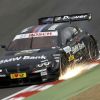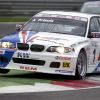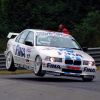DTM safety concept explained
On 31st October 2010, DTM driver Alexandre Prémat experienced a moment of horror during the penultimate race of the season at the Adria International Raceway. The Frenchman’s car hit the crash barrier, flew several metres into the air, somersaulted, and then landed at the side of the track, a complete write-off. After his accident, the Audi driver was able to climb out of his car unaided and uninjured.
This much was apparent straightaway: the DTM safety concept works well and is in no way inferior to systems common in Formula One. The DTM safety concept is basically comprised of a carbon-fibre outer skin, a safety cell, carbon-fibre crash boxes and a seat box for the driver that resembles the monocoque of a Formula One car.
“The introduction of carbon-fibre seat boxes in today’s DTM cars was one of our initiatives,” reveals Norbert Haug, Vice President, Mercedes-Benz Motor Sport. Safety equipment accounts for around a third of the cost of a DTM car, and, in the event of an accident, the driver must be able to exit from the vehicle within seven seconds using the driver’s door and within nine seconds by means of the passenger door.
DTM safety measures at a glance
Carbon-fibre seat box
In order to ensure that the driver is as safe as possible, he is literally cocooned in a carbon fibre seat box. This box equates to a Formula One racing car monocoque in its construction. It takes up the whole of the interior and is reinforced at the sides to give the driver additional lateral crash protection. It must be able to resist high loadings in crash tests.
Safety cell
Apart from the seat box, a tubular frame of high-tensile aviation grade steel gives further protection from accidents and somersaults. The fuel tank, situated next to the driver, is also integrated into the passenger compartment’s safety cell structure, just like the seat box. There’s a flexible, tear-resistant rubber bladder beneath the tank’s carbon fibre outer skin that forms the actual tank.
Crash boxes
Front and rear crash boxes are fitted to all vehicles as prescribed by DTM rules. The front crash box extends from the axle to the car’s front end. The rear crash box is in the ‘boot’. In an accident, both engine and gearbox provide additional protection by absorbing energy. Crash boxes are subjected to static and dynamic testing in crash tests.
Head restraints
Head restraints in a DTM car have special pads on each side that protect the driver’s head from buffeting. Just like in Formula One, these restraints are covered with special foam that absorbs energy on being struck by the helmet, and protects the driver’s brain.
HANS
HANS stands for “head and neck support”. In an accident, this system protects the driver’s spinal cord from overextension and stops the head from hitting the steering wheel. Mercedes-Benz helped to develop the Formula One version.










